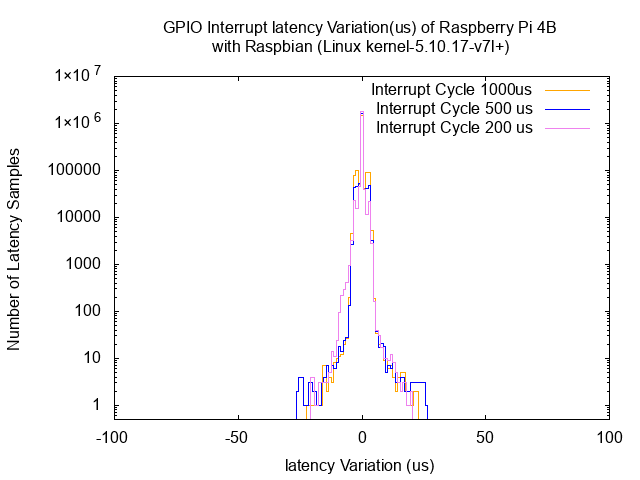Does the worst PCIe MSI interrupt latency jitter over 100us normal?
0
votes
0
answers
620
views
I try to figure out the values of interrupt jitter in Linux, especially in the worst cases.
Two testbeds are considered, one is Raspberry Pi 4B, the other is a high-end PC with an intel i9 CPU and ASUS motherboard.

 My Question are:
1 Why the PCIe MSI interrupts have larger latency jitters than the GPIO interrupt's ?
2 Is it normal that the morden PCIe MSI interrupt have about 100us latency variation under the worst condition (Is there anything I missed)? How can I minimize such variations in latency (jitter).
My Question are:
1 Why the PCIe MSI interrupts have larger latency jitters than the GPIO interrupt's ?
2 Is it normal that the morden PCIe MSI interrupt have about 100us latency variation under the worst condition (Is there anything I missed)? How can I minimize such variations in latency (jitter).
+-+ +-+ +-+ Raspberry Pi 4B
| | | | | | -------------+
--+ +-+ +-+ +- 1. GPIO | +--------------+
Signal Generator | | |
+----> +-----+ | Linux |
| CPU | | ------------ |
+----> +-----+ | Kernel |
| | | | |
+-+--+-+ 2. PCIe MSI | +--------------+
--+ FPGA +-- ------------+
+-+--+-+ high-end PC (i9-9900K)
| |irq_handler function of the driver code in the high-end PC
// IRQ handler
static irqreturn_t fPCI_event_isr (int irq, void *cookie)
{
struct timespec64 tsc_now = {.tsc_high = 0; .tsc_low = 0};
struct fPCI_dev *drv_data = (struct fPCI_dev *) cookie;
int nwritten;
int fifo_size;
// get TSC timestamp
get_tsc_cpuid((tsc_now.tsc_high), (tsc_now.tsc_low));
spin_lock(&(drv_data->spin_lock));
nwritten = fpci_fifo_write(drv_data->fifo, &tsc_now, 1);
spin_unlock(&(drv_data->spin_lock));
if (nwritten != 1)
printk(KERN_INFO, "fPCI_event_isr: fifo overflow!\n");
fifo_size = fpci_fifo_size(drv_data->fifo);
if (fifo_size > FIFO_SIZE/2)
wake_up(&(drv_data->waitqueue));
return IRQ_HANDLED;
}
In the code of IRQ handlers, first, the current time is stored in a FIFO. Then, a user-space thread reads time data from the FIFO, and counts the jitters of the interrupt.
The results are showed in following two figures.

 My Question are:
1 Why the PCIe MSI interrupts have larger latency jitters than the GPIO interrupt's ?
2 Is it normal that the morden PCIe MSI interrupt have about 100us latency variation under the worst condition (Is there anything I missed)? How can I minimize such variations in latency (jitter).
My Question are:
1 Why the PCIe MSI interrupts have larger latency jitters than the GPIO interrupt's ?
2 Is it normal that the morden PCIe MSI interrupt have about 100us latency variation under the worst condition (Is there anything I missed)? How can I minimize such variations in latency (jitter).
Asked by foool
(111 rep)
Sep 14, 2021, 08:08 AM